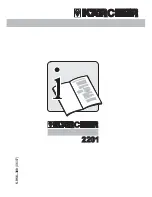
3
Tanis Technologies 24 Series Filtration Unit
Revised 07.01.2020
General Safety information
SAFETY GUIDELINES
-
DEFINITIONS
This manual contains information that
important for you to know and
understand. This information relates to
protecting YOUR SAFETY and PREVENTING
EQUIPMENT PROBLEMS.
GENERAL SAFETY RULES
!WARNING!
This machine was designed for certain
applications only. Tanis Technologies
strongly recommends that this
machine not be modified and/or used
for any application other than that for
which it was designed. If you have any
questions relative to a particular
application, DO NOT use the machine
until you have first contacted Tanis
Technologies and confirmed that the
product is suited for your application.
!WARNING!
Failure to follow these rules may result
in serious personal injury.
1. For your safety, read and
understand the instruction manual
before operating the unit.
Learn
the unit
’
s application and limitations as
well as the specific hazards, related to
it.
2
. Don
’
t use in dangerous
environment.
Don
’
t use this unit in damp or wet
locations or expose to rain.
3.
Disconnect unit
before servicing.
4. Check damaged parts
before
future use of the unit, properly repair
or replace any part that is damaged.
ADDITIONAL SAFETY RULES FOR
AIR CLEANERS
1. Install AF
-
24XX series air cleaners
according to all electrical and safety
codes as well as the National Electrical
Code (NEC) National Fire Protection
Association (NFPA) and the
Occupational Safety and Health Act
(OSHA). Only someone who is
qualified to do electrical work should
wire the units in.
2. These air cleaners are intended to
be installed at least
8.2 feet (2.5
meters) above the floor.
3. Specific duct design and dust
collector configurations are required
under standards set forth by the
National Fire Protection Association
(NFPA). These are applicable when
collecting potentially reactive metal
dusts (like aluminum, magnesium and
other materials). NFPA also has
standards that cover other dusts like
grain and plastics, ect. For guidelines
on determining which precautions
should be taken, please refer to NFPA
497. There may be other
specifications that apply for your
particular application, so please
consult current NFPA standards that
may be acquired at:
NFPA
1 Batterymarch Park
Quincy, MA 02269
1
-
800
-
344
-
3555
This information may contain
safeguards that are required for the
installation, operation and service of
AF
-
24XX series products.
!
WARNING!
4. Avoid mixing combustible
materials like (but not limited to) the
following: buffing lint, paper/wood
dust, aluminum or magnesium with
dust generated from the grinding of
ferrous materials. This creates a
potential for fires due to the mixing of
sparks and combustible materials.
5. A machine operator should NEVER
be allowed to put lit cigarettes or any
burning object into this or any dust
control system.
6. If there is a chance for heated and/
or flammable materials to enter the
unit, installation of the unit should be
evaluated to determine if a fire
protection/exhaustion systems should
be installed. Federal, State or local
codes, as required by organizations
such as NFPA and Factory Mutual
Insurance or your insurance carrier
may require such a system.
Tanis
Technologies can offer basic
guidelines for such an installation:
however, final installation design is
the responsibility of the purchaser.
7. Securely anchor unit to a permanent
or fixed supporting structure, be sure
the structure is rated to hold the
weight of the unit.
8. Support this unit or clamp it to the
work surface when using it in a
portable application to eliminate
potential injury or damage to the unit
9. Ensure that the intake and exhaust
areas are clear prior to starting the
unit. Clogged intakes or exhaust can
cause explosion and/or fire.
10. Keep arms and fingers away from
fan. Avoid all exposure to rotating
parts to prevent injury.
11. Do not attempt to remove/replace
filters while unit is running. Fan
blades can cause severe cuts. Be sure


























